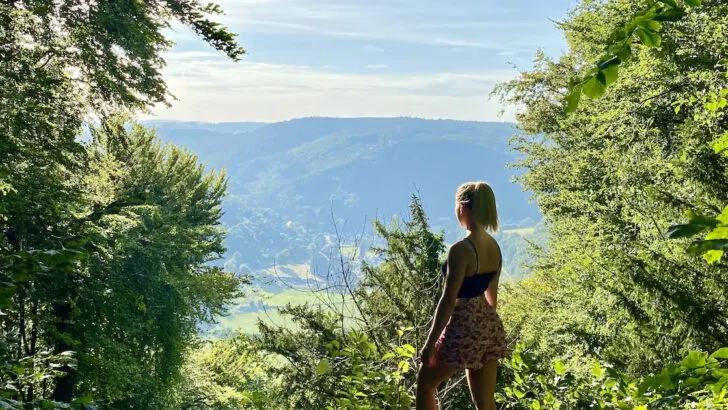If you’re visiting the Wye Valley to visit the Gothic masterpiece of Tintern Abbey, I can’t think of a better idea than going on one of the best Tintern Abbey walks.
The Cistercian abbey has been slowly fading since the 12th century. However, the valley surrounding Tintern is packed with stunning woodlands and limestone slopes with evergreen fern, woodrush, and trees like ash, beech, lime, and oak.
On Tintern Abbey walks, you might spot wildlife such as peregrine falcons, red kites or herons. No wonder the Romantic poets raved about the Tintern Abbey walking trails; Wordsworth is quoted saying, “No poem of mine was composed under circumstances more pleasant”.
The abbey is located in Tintern village, which has a small pot of pubs and tea rooms, including dog-friendly locations. Without further ado, let’s jump into the best walks near Tintern Abbey to turn your quick trip into a full day out.
These Tintern Abbey walking trails traverse old railway lines, ruined wireworks and a boulder lookout with a devilish legend attached to it.
Disclosure: This post includes affiliate links. If you decide to click through and make a qualifying purchase, I will receive a small commission at no extra cost to you – thanks for your support.
QUICK INFORMATION
Best time for hiking: April to September
How to get there: Drive or take the bus from Chepstow or Monmouth.
Best tours of Tintern Abbey:
From Cardiff: 1-Day Brecon Beacons and Wye Valley Tour
From Bristol: 2-Day Wye Valley, Stratford Upon Avon, Oxford and Cotswolds tour
Are Tintern Abbey Walks Good For Beginners?
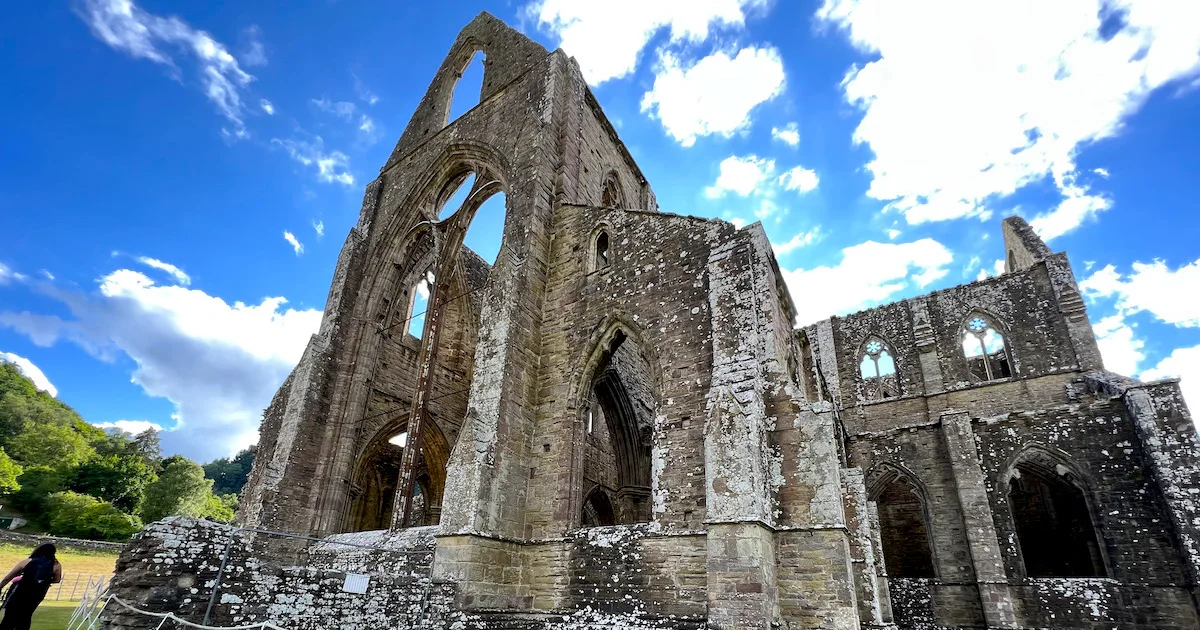
The four Tintern Abbey walks I will cover are suitable for beginners or moderately experienced hikers. They range from between two and a half miles to five miles.
The best walk for beginners is the Wye Valley Greenway, which does not have any incline.
Tintern Abbey Walks: The History of Tintern Abbey
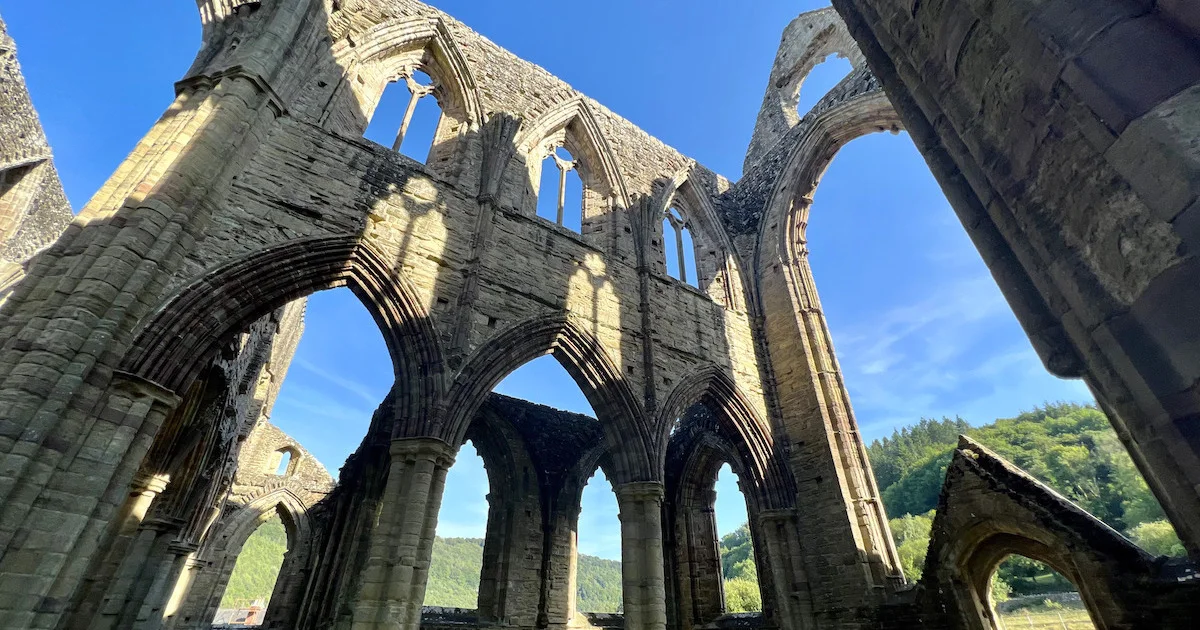
Tintern Abbey easily could have been plucked out of a scene from Harry Potter or an Enid Blyton novel.
The Cistercian abbey has thick stone walls connected by Gothic arches. Then, through the elaborate arched windows, there are views of the forest-clad slopes of the Wye Valley.
The abbey’s origins lie in 1131 with a community of Cistercian monks. They originally built humble timber buildings as their place of worship. However, over the next few years, they built a church, and in 1269, they built the abbey that we see today.
The monks’ abbey was a grand piece of Gothic architecture at the time. However, it fell into ruin within a year of being built after Henry VIII’s reformation.
Tintern Abbey is located in a small village on the banks of the Wye Valley in Wales. It’s not a place that most people pass by on their daily business, even back in the 17th, 18th, and 19th centuries.
Therefore, it only really gained any recognition for its beauty when Romantic poets descended upon the Wye Valley searching for inspiration for their poetry. The notorious Lord Byron dedicated a whole poem to the abbey.
His friend and fellow poet William Wordsworth also visited a ledge above the Wye Valley called the Devil’s Pulpit, which features in the following Tintern Abbey walks.
Tintern Abbey Walks: Where is Tintern Abbey?
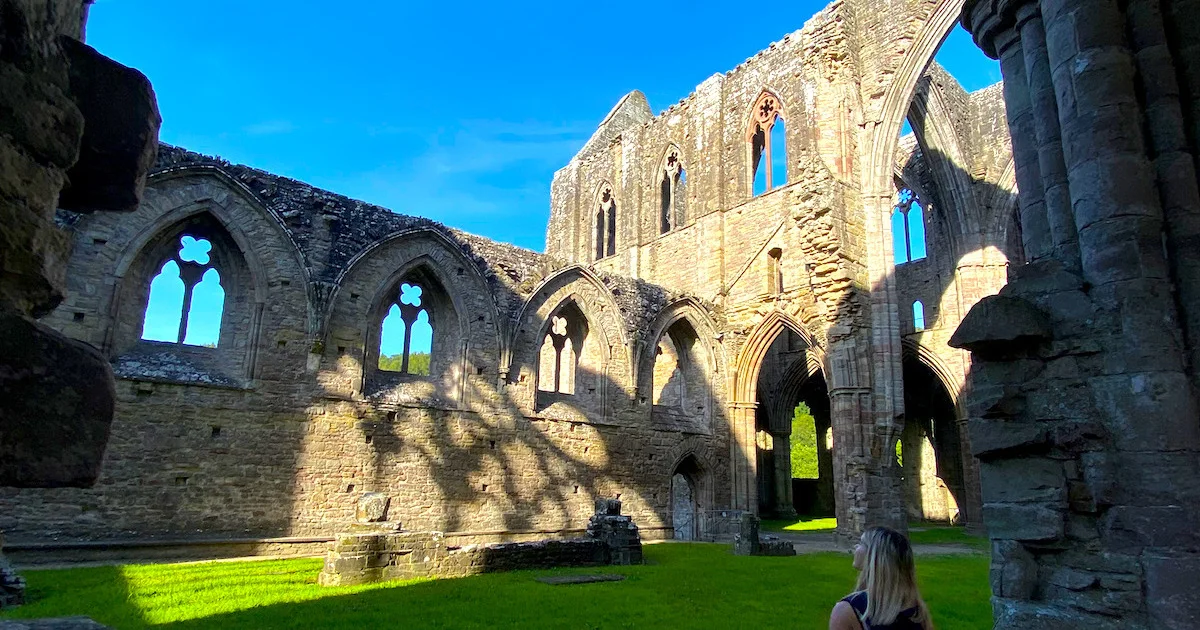
Tintern Abbey walks are exceptionally scenic. The proof is in the pudding; the Wye Valley is a designated Area of Outstanding Natural Beauty, which is a title only given to the most impressive landscapes in the United Kingdom.
The village only has a population of 853. Aside from a couple of pubs, tea rooms, a visitor’s centre and the adorable Abbey Mill venue, there’s not much else.
The River Wye passes through Tintern. The river forms the border between Monmouthshire and Gloucestershire, making the walks around Tintern easy to get to for anyone residing in England or Wales.
How to Get to Tintern Abbey Walks
The easiest way to visit the walks near Tintern Abbey is by driving. It is a 35-minute drive from Bristol and approximately 50 minutes from Cardiff or Bath.
Otherwise, there is a local bus stop in the village, which has connections to Monmouth and Chepstow.
In Monmouth and Chepstow, there are train stations with direct trains to cities such as Cardiff and Bristol. I always use Trainline to book my train tickets in the UK, as it has an intuitive app and you can show the ticket to the conductor on your smartphone.
The nearest airports to Monmouth and Chepstow are Bristol Airport or Cardiff Airport.
Alternatively, if you don’t want to use public transport, there are several tours which have majority five-star reviews from Cardiff and Bristol. The only downside is that they don’t involve much hiking, so they’re best for those who want to sightsee.
- From Cardiff: 1-Day ‘Wandering Bards’ Tour of the Valleys
- From Cardiff: 1-Day Brecon Beacons and Wye Valley Tour
- From Bristol: 2-Day Wye Valley, Stratford Upon Avon, Oxford and Cotswolds tour
- From Bristol: 3-Day Welsh Mountain and Coasts Tour
What to bring on Tintern Abbey Walks
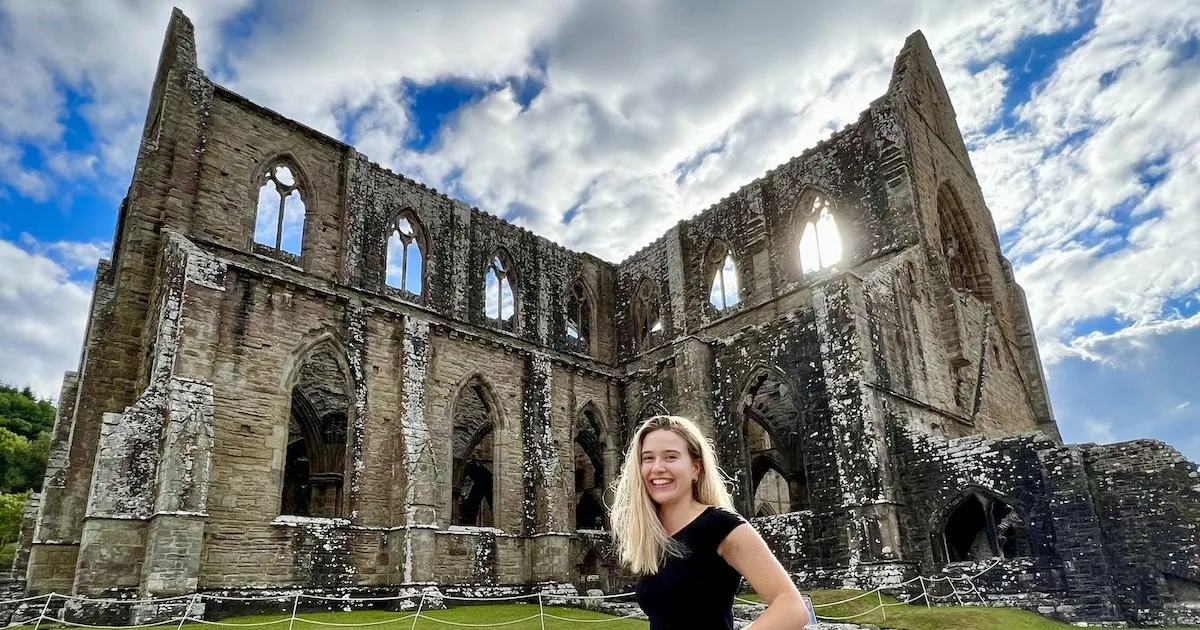
Any packing list for the following Tintern Abbey walks doesn’t have to be complicated. However, there are a few essentials that you might want to bring along.
If you don’t want to bring a packed lunch, there are pubs and coffee shops in Tintern village which sell food. Several are dog-friendly.
Sturdy hiking shoes or trainers with a good grip are important. There are some steep slopes and gravel on the trails. Sections of the Tintern walking trails are also prone to mud.
Consider packing:
- 1 – 2 litres of water.
- Packed lunch and/or snacks.
- Lightweight raincoat.
- Sunglasses, sun cream or a sun hat for sunny weather.
- Toilet paper – just in case.
Where to Park for Tintern Abbey Walks
There are several car parks in Tintern. The best place to park for Tintern Abbey and its walking trails is either the Anchor Inn car park or the Tintern Abbey car park.
The Anchor Inn car park is the first car park you come across after turning into the road opposite the abbey.
It costs £3 per day, and you can get the full price of the ticket back if you buy a drink or a meal in the pub.
The Tintern Abbey car park is further down the same road, next to the entrance to the abbey. This car park also costs £3. Again, the ticket price is redeemable if you buy a ticket to the abbey. You can check up-to-date ticket prices on the Tintern Abbey page.
If you want to visit the pub for lunch, that’s the best car park for you. If you’re going to pay for an abbey entrance ticket, park in the abbey car park instead. Both car parks are within a few steps of each other.
Both car parks are cash-only.
They have limited disabled parking spaces.
There are public toilets between the two car parks.
If the main two car parks are full, there’s an additional car park located at Wireworks Tintern on Forge Road. This is a small, free car park. However, it’s a 10-minute walk from Tintern Abbey and it doesn’t have any toilet facilities.
A fourth car park is located at the Tintern Furnace Car Park, which is further away.
Where to stay in Tintern
If you want to tackle multiple trails, you can stay overnight in Tintern village. There are only a few options in the actual village, although there are far more hotels in Chepstow or Monmouth.
I’d suggest filtering hotels using the map filter on Booking.com.
I’ve rounded up the best-rated accommodations in Tintern Village the nearby village of Tintern Parva:
Wye Valley Hotel, Tintern Village: 9/10 rating
Self-catering accommodation:
- Holmleigh Cottage, Tintern village (9.6/10 rating)
- Parva Farmhouse Riverside Guesthouse, Tintern Parva (9.1/10 rating)
- Wye View, Tintern village (9/10 rating)
Four Tintern Abbey Walks You Must Try
There are a handful of Tintern Abbey walks. The first things to consider when choosing which walk you do is:
- How long do you want to walk for?
- How difficult do you want the walk to be?
- Do you want views of the abbey?
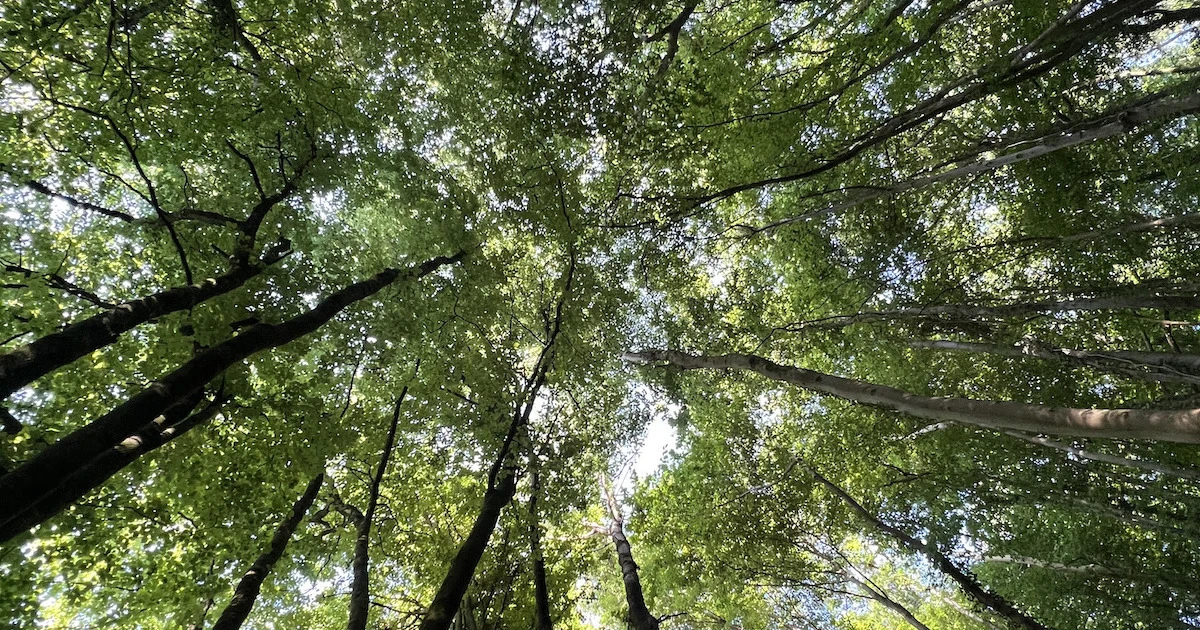
If your answer to number three is yes, skip to the first trail in my list, the Devil’s Puplit. The best view of the abbey is from the Devil’s Pulpit walk, where there is a ledge overlooking Tintern village.
The walks in my round-up range from 2.5 miles to 5 miles long. However, there are two long-distance trails which pass through Tintern: the Wye Valley Way and the Offa’s Dyke Path.
Both of these trails travel alongside the river Wye towards Monmouth and/or Chepstow, visiting scenic lookout spots such as Wintour’s Leap and The Wyndcliff if you have time to walk further.
However, if you want to start and end the trails in the village, you will need to follow the trail out-and-back (following the same path in both directions). This means you see the same scenery twice.
If you’re looking for the easiest walk in Tintern, skip to my overview of a short section of the Wye Valley Greenway which follows an old railway line and crosses through an eerie old railway tunnel. Brockweir Circular is another easy option; it passes by Tintern Old Station and St Michael’s Church.
1. Devil’s Pulpit and Offa’s Dyke
Best for: An uphill woodland walk with views over Tintern Abbey
Length: 5 miles (approximately 2.5 hours)
Difficulty: Moderate
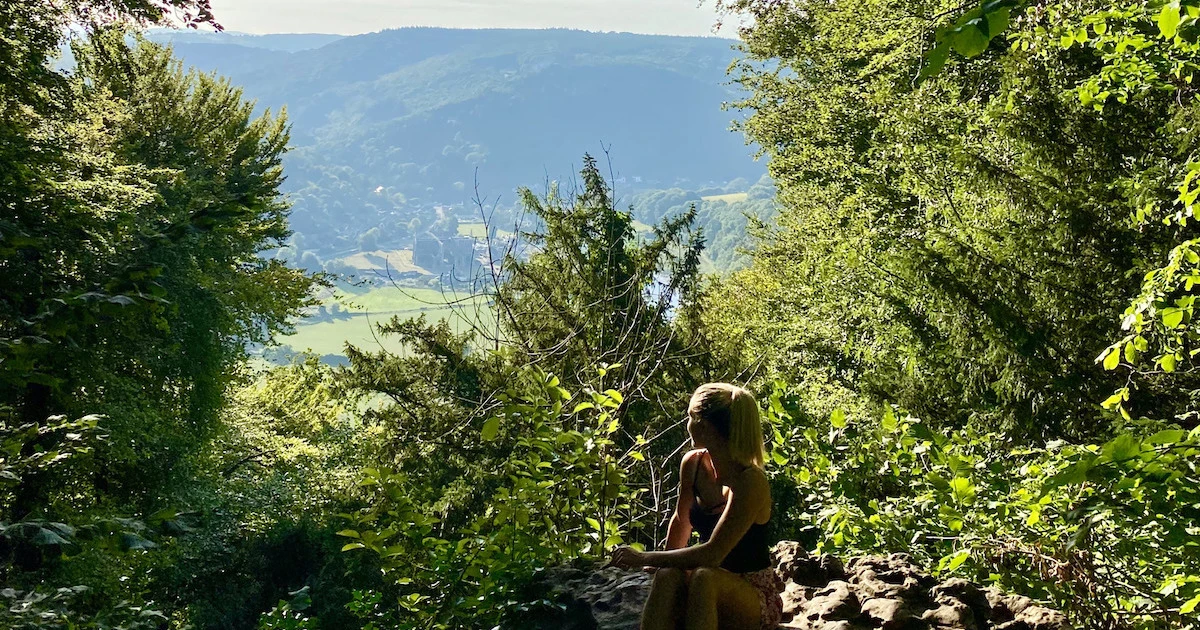
The Devil’s Pulpit is the best Tintern Abbey walk, in my opinion. It has distant views of the Tintern Abbey ruins and spectacular Wye Valley scenery.
What’s with the name? According to legend, the Devil preached to the abbey’s monks from the limestone ledge, taunting them to leave their place of worship.
At the top of the trail, there is a limestone boulder which you can scramble – it requires you to be a confident scrambler. This is a great spot to pose for a photo.
Regardless, the woodland walk is photogenic. Just check out the moss-covered trees and upturned tree roots.
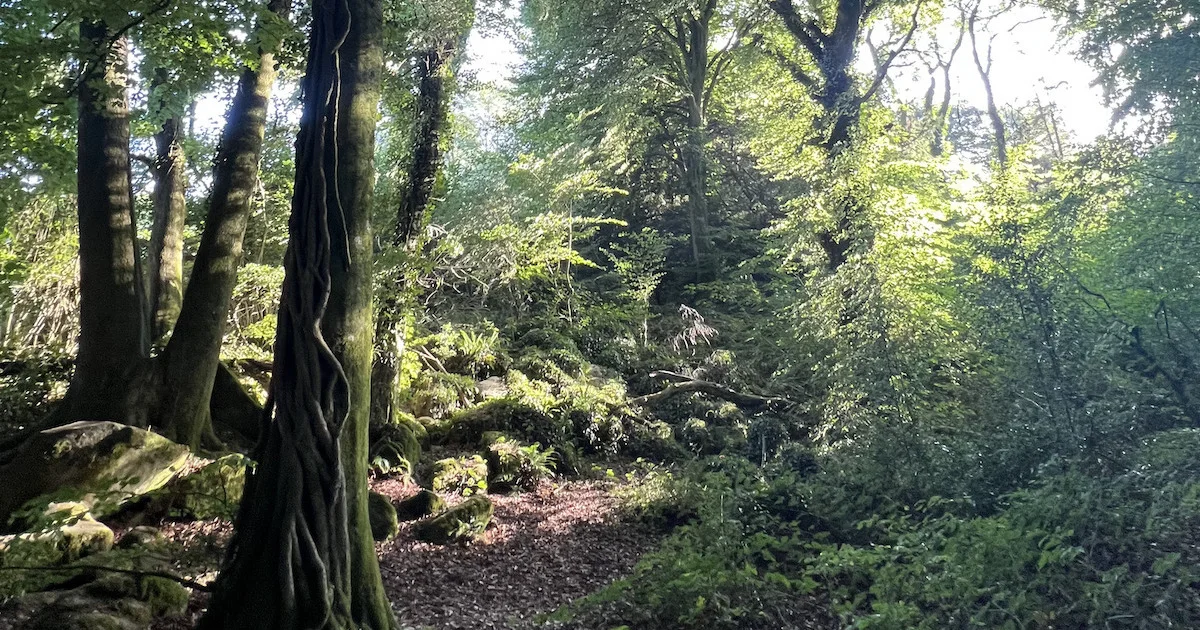
As part of the route follows along the Offa’s Dyke Path, it’s possible to extend the hike by staying on the Offa’s Dyke Path.
The route
- From the car park outside of Tintern Abbey, locate the Anchor Inn pub opposite the abbey.
- Join the footpath between the pub and the River Wye.
- Follow the footpath along the riverbank until it veers left into Tintern village.
- At the main road (the A466), turn right.
- Walk along the main road until you reach Abbey Mill, a historic centre with a coffee shop, shops, and outdoor seating.
- Walk around Abbey Mill, turning right towards the Wireworks Bridge over the River Wye.
- Cross the Wireworks Bridge over the River Wye.
- Follow the path around to the right until you reach the first trail veering uphill to the left. It is marked by metal poles.
- Follow the trail uphill. At the next junction, take the trail on the right-hand side.
- At the next junction, veer left.
- Shortly after this turning, there will be another junction. This time, follow the left-hand trail uphill.
- At the T-junction, continue following the path to the right, ignoring the next turnings on the left and on the right.
- At the next junction, take the path on the left-hand side and follow it uphill.
- At the next T-junction, turn right.
- The Devil’s Pulpit Viewpoint is straight ahead.
- After visiting the Devil’s Pulpit, continue along the same trail.
- Follow the trail through the woods, ignoring any turnings to the right or the left. You want to follow the path in a loop around Caswell Wood. There will be two right-hand turnings along the footpath after the Devil’s Pulpit viewpoint. These paths join up with the bottom path, which is your route back to Tintern Abbey. However, to stay on the full circular route, ignore the first two right-hand paths and take the right at the first T-junction you come to following these.
- Follow this path in a circular route around Caswell Wood. You will come across one crossroads, where you need to continue straight.
- Follow the path all the way back to Wireworks Bridge and retrace the same route back to Tintern Abbey.
2. The Wye Valley Greenway
Best for: A level path along an old railway line, passing through an eerie 1079-metre tunnel.
Length: 5 miles (approximately 2.5 hours)
Difficulty: Easy
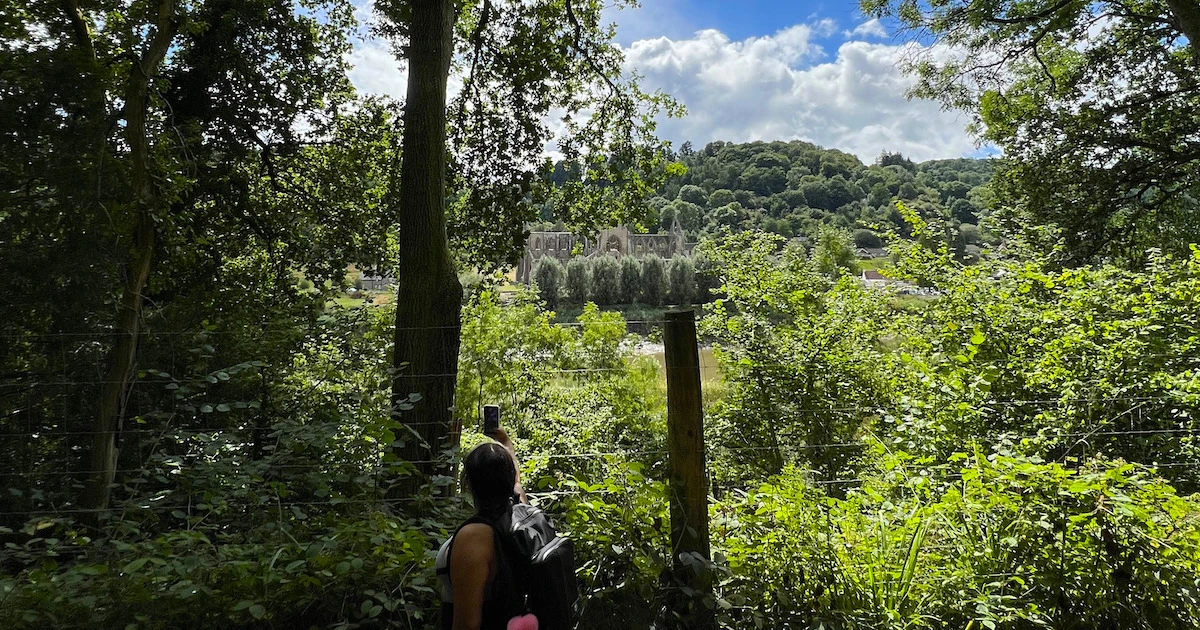
The first thing you need to know about the Wye Valley Greenway route from Tintern Abbey is that it it is an out-and-back trail. This means that you will walk in one direction, then take the same route back to your original destination.
The Wye Valley Greenway has limited views of the abbey because it is a flat trail which traces an old railway line along the riverside. Most of the views are obscured by trees and bushes, so it is primarily a woodland walk.
It’s very flat, making it good for those who want an easy walk. It’s a good option if you want to catch up with a friend or walk with the family. At one point, a peregrine falcon dove over the path ahead of me, so if you’re a birdwatcher, bring your binoclaurs.
The path follows the Wye Valley Railway Line which first opened in 1876. The line closed in the mid 1900s.
The halfway point is the eeriest spot along the trail: Tidenham Tunnel, a 1079-metre-long tunnel which is dimly-lit and home to a large bat population.
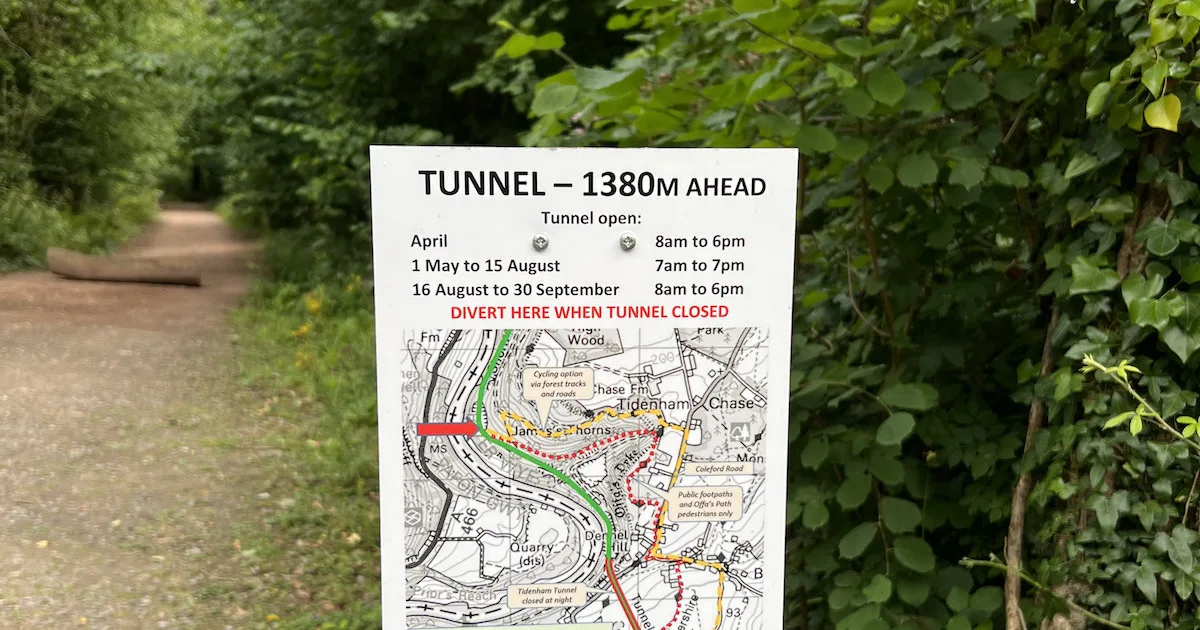
You can then extend the walking trail by veering left at the beginning of Tidenham Tunnel, where there is a path which leads to the Devil’s Pulpit circular walk.
The Wye Valley Greenway is suitable for hiking and cycling, but cyclists will need their own wheels as there aren’t any bike hire facilities in Tintern village.
The route
- From the car park outside of Tintern Abbey, take the footpath between the Anchor Inn pub and the River Wye.
- Follow the footpath to the main road in Tintern (the A466).
- Turn right on the main road and continue until you reach Abbey Mill and the Wireworks Bridge over the River Wye.
- Cross over the Wireworks Bridge, just right of Abbey Mill.
- After crossing the river, follow the footpath around to the right.
- Ignore any turns on the left and continue straight.
- Follow the trail directly to Tidenham Tunnel, passing through the tunnel.
- Retrace your steps back through the tunnel and back to Tintern Abbey.
3. Brockweir Circular
Best for: A pleasant walk along an old railway line with an old Victorian station enroute.
Length: 2.5 miles (approximately 1.5 hours)
Difficulty: Easy to moderate
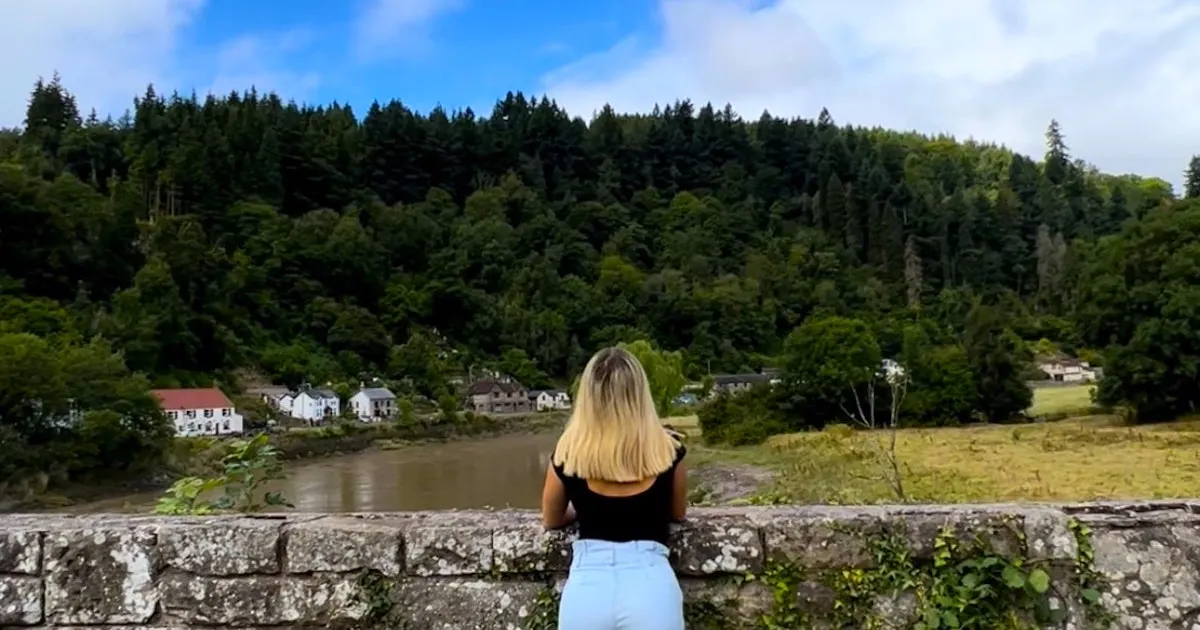
Brockweir Circular traces the old railway line between Tintern and the village of Brockweir. It passes by the historic Old Station in Tintern, a Victorian station with a tearoom and visitors centre, as well as the stunning Wye Valley countryside.
Brockweir village was named after a prince of Gwent named Brockmael. It was once a little riverside port town with a quayside and managed shipbuilding and repair for many of the ships that were tasked with shifting cargo up and down the valley.
Interestingly, the village actually gained a reputation for debauchery like gambling and drinking, and there were 16 pubs at one time.
The church, built in the 1820s, was invested in helping the villagers. So, there’s plenty to see along the walk.
- Begin the hike from the Tintern Abbey car park by making your way to the path that runs between the Anchor Inn pub and the River Wye.
- Follow the path until you emerge at the main road running through Tintern (the A466).
- Turn right and follow the main road past the Abbey Mill centre.
- When you reach the Wye Valley Hotel, still on the A466, take the turning to the right signposted St Michael’s Church.
- Past the church, join the riverside path on the right-hand side.
- Follow the footpath over several bridges, ignoring any left-hand trails to Old Station.
- As you approach Brockweir Bridge, take the left-hand turning onto the gated trail.
- Climb the steps to the road.
- Turn right, crossing over the bridge, and follow the main road through the village of Brockweir.
- Take the first road to the right, passing by the village malt house. Then, turn right down a narrow footpath. The footpath squeezes between houses and gardens, and emerges at Moravian Church.
- Climb over the stile into the fields and walk along the riverbank.
- Then, take the path to the left, which heads in the opposite direction of the river.
- Climb over the stile onto the bridleway.
- Turn right and follow the footpath uphill into the woodlands.
- At the next junction, continue straight and follow the path downhill.
- At the old tramway, turn right and then walk left towards Wireworks Bridge.
- Cross Wireworks Bridge and retrace the original route back to Tintern Abbey.
4. Angidy Valley Trail
Best for: A scenic heritage walk stopping at old wireworks, streams and ponds
Length: 3.8 miles (2 hours and 15 minutes)
Difficulty: Moderate
The Angidy Valley Trail takes in everything from wirework ruins to peaceful ponds, streams, and beech woods.
Back in the days, the Angidy Valley was very involved in producing wire. Angidy wire was extremely high-quality and used for fishing hooks, bird cages, gun wiring, and even Elizabethan garments such as stomachers and farthingales.
If the stories are correct, Angidy wire was also used in the first transatlantic telegraph cable.
In 1895, the metalworks shut because business was no longer booming. However, the remains are still around the trail for you to take in, including the remains of the Abbey Tintern Furnace.
- Begin the walk at Tintern Abbey car park by following the footpath between the Anchor Inn pub and the River Wye along the riverbank.
- After passing through the village, exit onto the main road in Tintern (the A466).
- Cross the main road and follow Forge Road uphill, ignoring the trail to Chapel Hill Road on the left-hand side.
- Just as the road reaches a bend, turn left onto the sloping driveway signposted for Penterry Church.
- Passing the cottage, follow the footpath uphill alongside the stream.
- You will pass underneath a bridge made from planks. After the bridge, turn right, and then turn right again at the next driveway. Take the immediate turning to the left, which heads onto the left-hand side of the wall which separates the two driveways.
- At the end of the wall, rejoin the original driveway.
- Continue to the road through the forest, turning right onto the downhill slope through beech trees.
- Cross over the next junction and continue walking until you reach the dam. There should be a bench by the dam.
- Take the left-hand turning and follow the pond to the footbridge.
- Follow the path to the road, turning left and then immediately right into the Abbey Tintern Furnace ruins car park.
- On the other side of the ruins, take the footpath along the stream and ascend to the road.
- At the signpost for Raglan, turn right, crossing the stream.
- At the next junction, take the left-hand turning signposted for The Fedw. You should pass a farmhouse and cross over a stream, before turning left at the Cross Farm entrance.
- Follow the road back to the pond.
- At the next junction, take the right-hand turning signposted Tintern.
- Follow the road back to Abbey Tintern Furnace and cross over the stream.
- After the farm, take the footpath on the right and cross over the footbridge over the pond.
- Turn left twice, taking the riverside path which eventually merges with another trail.
- Continue walking along the right-hand side of the stream until you reach a narrow lane. Turn left before the junction, following the footpath behind the house.
- Follow the stream back to the road.
- Turn left onto the road.
- At the next junction, turn right and continue following the road until you reach Tintern Village.
- Retrace the route back to Tintern Abbey.
Things to do after completing one of the Tintern Abbey walks
1. Visit Tintern Abbey

Once you have completed one of the Tintern walking trails, you can visit Tintern Abbey. The gothic abbey is glorious to look at from the road. However, it’s even more impressive when you’re standing directly inside.
A section of the abbey is open to the public, although you must keep to the designated paths because pieces of the abbey are continuously crumbling off despite restoration efforts.
Disabled visitors go free, and younger and senior visitors also get discounted tickets.
2. Have a pub meal
There is a traditional pub next door to Tintern Abbey, the Anchor Inn pub. It has a large garden terrace and views of the abbey.
The Sunday roast was a welcome treat following my first Tintern Abbey hike, but they also have a staple menu containing typical British pub grub like fish and chips, Wye Valley rump steak, and breaded scampi.
There are a couple of other pubs in Tintern village. They are called The Wild Hire and The Rose & Crown, but I haven’t visited them and I can’t vouch for the food.
3. Visit Abbey Mill
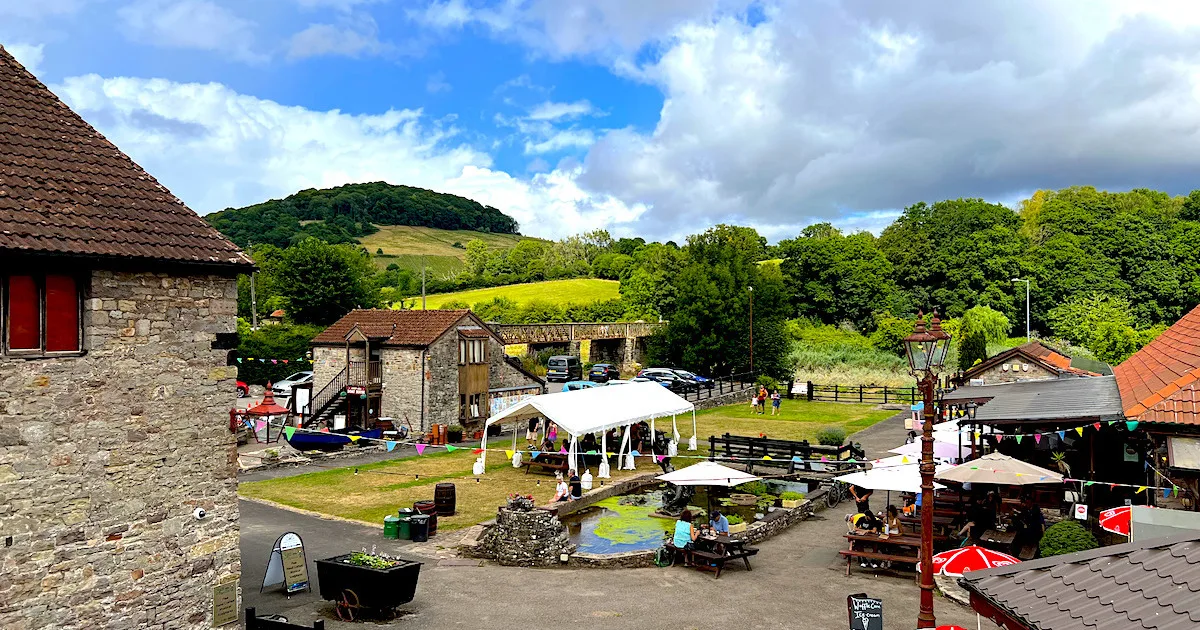
Abbey Mill is another excellent spot to unwind after you’ve completed your chosen Tintern Abbey hike. The original mill was established in 1131.
The old mill buildings now house craft shops, a coffee shop, and a restaurant serving alcoholic or soft drinks. The watermill also runs at certain times of the day.
Check the opening times before you visit because they vary depending upon the time of year. They are usually closed on Mondays and Tuesdays.
4. Visit a coffee shop
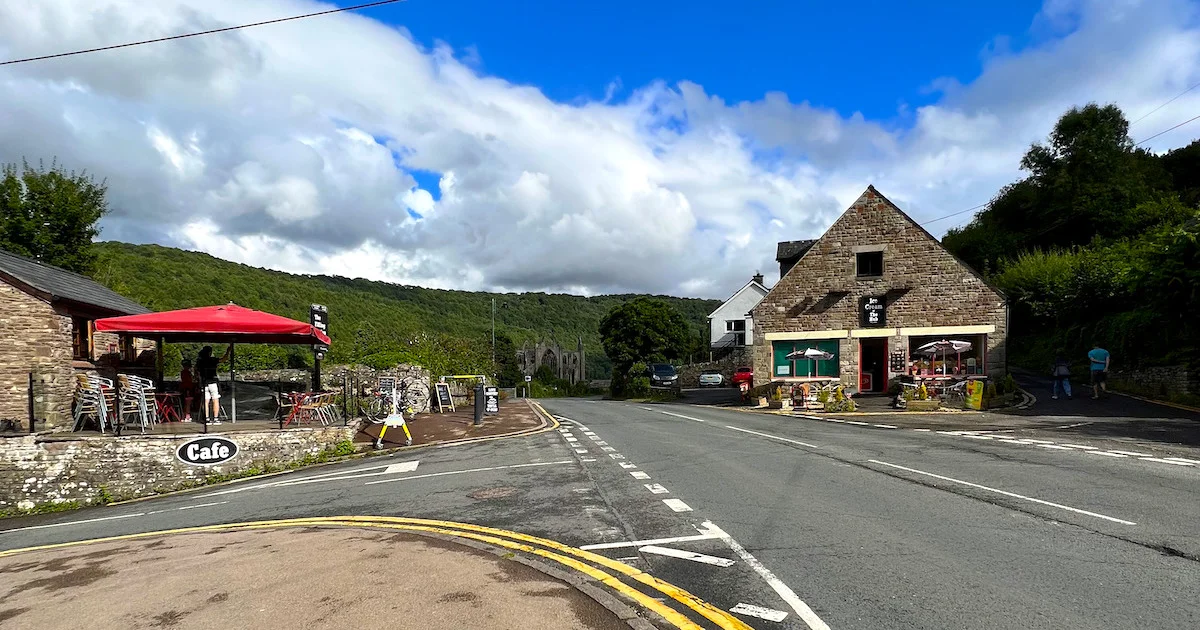
There are several other coffee shops around Tintern, where you can grab a coffee or an ice cream. They’re known for being dog-friendly; Tintern is a dog-friendly village and there are free poop bag stations deposited around the village.
The coffee shops in Tintern include the Filling Station Cafe, the Abbey Mill Coffee House and an ice cream shop.
Suggested reading:
- Best beaches in Gower, Wales
Best resources for visiting Wales:
- Book hotels on Booking.com
- Find train tickets on Trainline
- Search for tours on GetYourGuide
- Save money by housesitting on TrustedHousesitters
AUTHOR
Katie Treharne

I’m Katie, the owner of Escape Artist Katie. I have been travel writing since 2018, including writing for luxury travel magazines and publications such as Wanderlust.
As well as being a digital nomad who works and lives abroad permanently, I’m a big advocate for offbeat travel and pushing yourself out of your comfort zone.
I hope you found my article useful – find out more about me here or keep up with my travels on Instagram.

